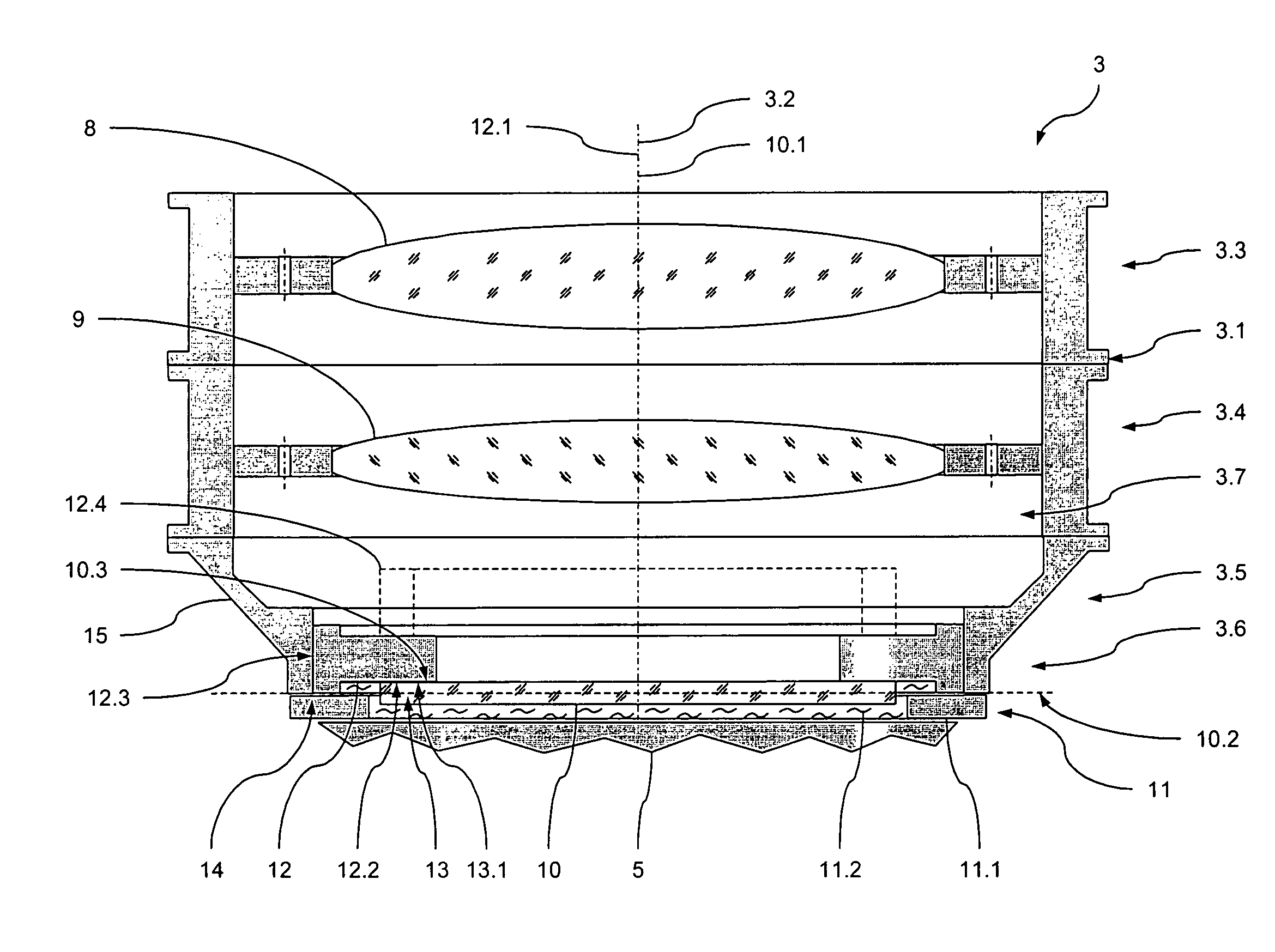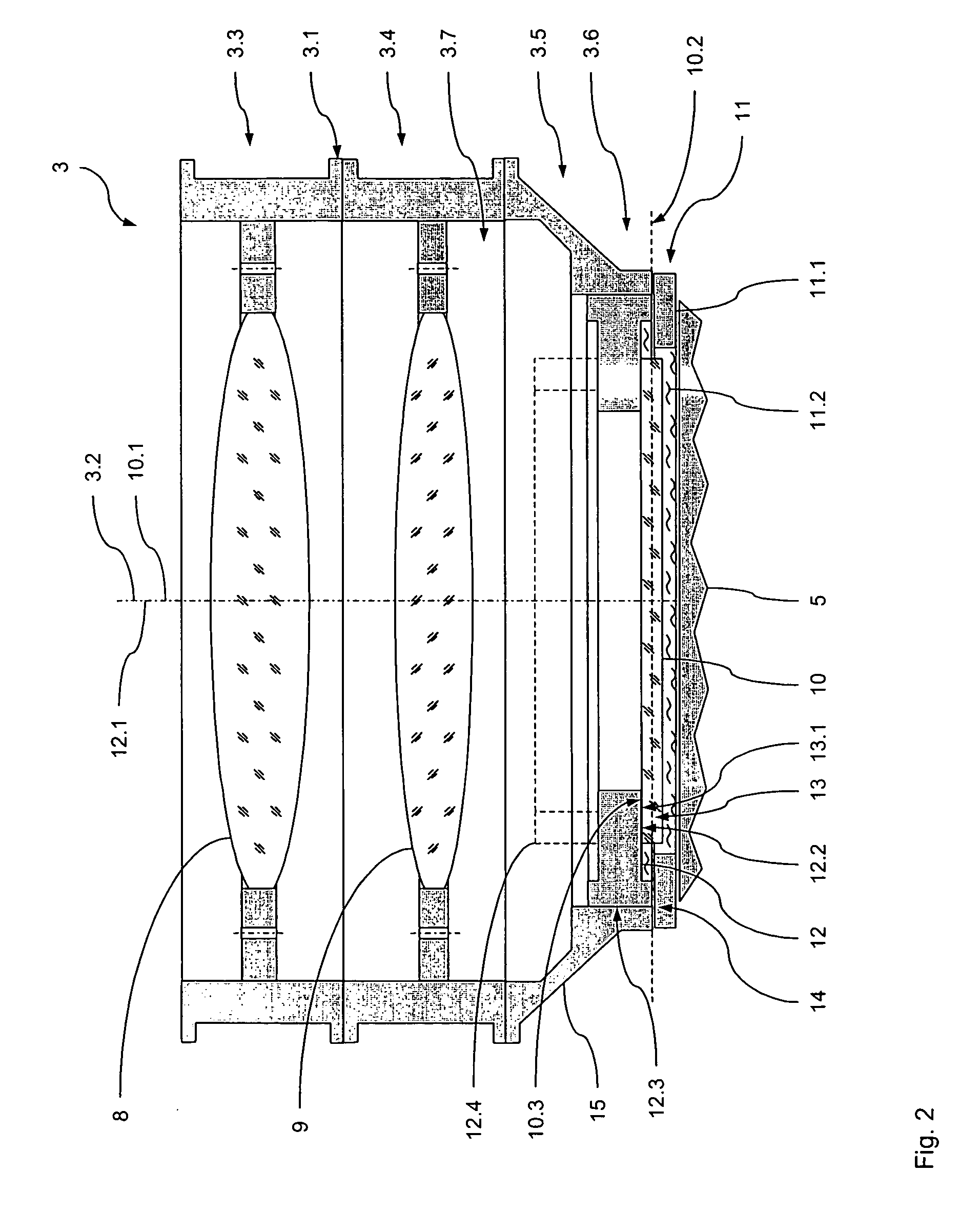Optical element module
a technology of optical elements and modules, applied in the field of optical element modules, can solve the problems of reducing the rigidity of the support system, increasing stresses, and the likely inability of adhesives to provide a desirable long-term stable and rigid connection, and achieve good and long-term reliable imaging properties of the optical system
- Summary
- Abstract
- Description
- Claims
- Application Information
AI Technical Summary
Benefits of technology
Problems solved by technology
Method used
Image
Examples
first embodiment
[0034]In the following, a first preferred embodiment of an optical exposure apparatus 1 according to the invention comprising an optical projection system 2 with an optical element unit 3 according to the invention will be described with reference to FIGS. 1 and 2.
[0035]The optical exposure apparatus 1 is adapted to transfer an image of a pattern formed on a mask 4 onto a substrate 5. To this end, the optical exposure apparatus 1 comprises an illumination system 6 illuminating said mask 4 and the optical element unit 3. The optical element unit 3 projects the image of the pattern formed on the mask 4 onto the substrate 5, e.g. a wafer or the like.
[0036]To this end, the optical element unit 3 holds an optical element group 7. This optical element group 7 is held within a housing 3.1 of the optical element unit 3. The optical element group 7 comprises a number of optical elements 8 and optical elements 9 and 10 such as lenses, mirrors or the like. These optical elements 8 to 10 are al...
second embodiment
[0070]In the following, a second preferred embodiment of an optical element module 103.5 according to the invention will be described with reference to FIGS. 1 and 4. In this embodiment, the optical element module 103.5 replaces the optical element module 3.5 within the exposure apparatus 1 of FIG. 1.
[0071]FIG. 4 shows a schematic sectional representation of the last optical element module 103.5 of the optical element unit 3. As can be seen from FIG. 4, the last optical element module 103.5 forming the exit end 3.6 of the optical element unit 3 comprises an ultimate optical element in the form of a lens 110 and an optical element holder 112 holding the lens 110.
[0072]The lens 110 is rotationally symmetric having a first axis of symmetry 110.1 essentially coinciding with the optical axis 3.2 of the optical element unit 3. The lens 110 mainly extends in a first plane 110.2 perpendicular to said first axis of symmetry 110.1.
[0073]The optical element holder is formed by a ring shaped fr...
third embodiment
[0089]In the following, a third preferred embodiment of an optical element module 203.5 according to the invention will be described with reference toFIGS. 1 and 5. In this embodiment, the optical element module 203.5 replaces the optical element module 3.5 within the exposure apparatus 1 of FIG. 1.
[0090]FIG. 5 shows a schematic sectional representation of the last optical element module 203.5 of the optical element unit 3. As can be seen from FIG. 5, the last optical element module 203.5 forming the exit end 3.6 of the optical element unit 3 comprises an ultimate optical element in the form of a plane parallel plate 210 and an optical element holder 212 holding the plane parallel plate 210.
[0091]The plane parallel plate 210 is rotationally symmetric having a first axis of symmetry 210.1 essentially coinciding with the optical axis 3.2 of the optical element unit 3. The plate 210 mainly extends in a first plane 210.2 perpendicular to said first axis of symmetry 210.1.
[0092]The optic...
PUM
 Login to View More
Login to View More Abstract
Description
Claims
Application Information
 Login to View More
Login to View More - R&D
- Intellectual Property
- Life Sciences
- Materials
- Tech Scout
- Unparalleled Data Quality
- Higher Quality Content
- 60% Fewer Hallucinations
Browse by: Latest US Patents, China's latest patents, Technical Efficacy Thesaurus, Application Domain, Technology Topic, Popular Technical Reports.
© 2025 PatSnap. All rights reserved.Legal|Privacy policy|Modern Slavery Act Transparency Statement|Sitemap|About US| Contact US: help@patsnap.com



